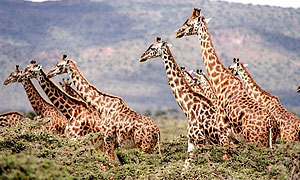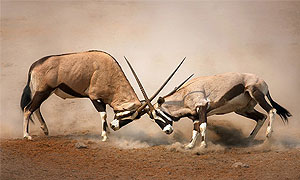Kenya National Parks Game Reserves
Kenya National Parks Game Reserves | Mount Kenya National Park & Reserve | Amboseli National Park | South Island National Park | Saiwa Swamp National Park | Sibiloi National Park | Ruma National Park | Ol Donyo Sabuk National Park | Ndere Island National Park | Mount Longonot National Park | Arabuko Sokoke National Park | Mount Elgon National Park | Meru National Park | Marsabit National Park & Reserve | Kora National Park | Chyulu Hills National Park | Central Island National Park | Tsavo West National Park | Lake Nakuru National Park | Tsavo East National Park | Nairobi National Park | Aberdare National Park | Hells Gate National Park | Malka Mari National Park | Mwingi Game Reserve | Nasolot National Reserve | Kakamega Forest National Reserve | Bisanadi National Reserve | Samburu National Reserve | Shimba Hills National Reserve | Mwea National Reserve

Kenya National Parks & Reserves; Kenya is home to a high number of great safari and wilderness destinations. The National Parks and Reserves exist with the aim of protecting Kenya’s flora, fauna, and ecosystems, as well as the diverse wildlife and birdlife.
Kenya’s national parks and game reserves are where people – Kenyans, visitors, and tourists go to experience the best Kenyan safaris. It is home to over 50 National Parks & Game Reserves, including six marine parks in the Indian Ocean.
With 23 National Parks, 4 National Marine Parks, 28 National Reserves, 6 National Marine Reserves, and 4 National Sanctuaries, there is a wealth of protected areas for travelers to explore in Kenya. For flora and fauna enthusiasts, we recommend safari tours to the world-famous Masai Mara National Reserve, Amboseli National Park, Tsavo National Park, Aberdare National Park, Mount Kenya National Park, and Samburu Game Reserve.
The sight of the annual migration of millions of wildebeests and zebras into the Masai Mara from Tanzania’s Serengeti National Park can be a lifetime experience for you. On safari in Kenya, you will find spectacular mountain sceneries, fabulous beaches, coral reefs, magnificent lakes and deserts, and widespread savannah grassland.
Kenya also has remarkable multi-ethnic cities, known for their rich and charming culture and architecture. Below is a list of all the Game Parks in Kenya. If you’re interested in making one or more of these parks your Kenyan safari destination, you’ll want to review the information on how to get to and around the parks, what to see and do, accommodations and camping sites, suggestions on how and where to book your safari, admission fees and the best time to visit each of the national parks in Kenya.
Below you will find a list of more information on some of Kenya’s most popular and most unique parks and reserves. It includes an overview, photos, and interesting facts about each of the main Kenya national parks. Each destination has its own highlights and attractions.
Kenya National Parks Game Reserves
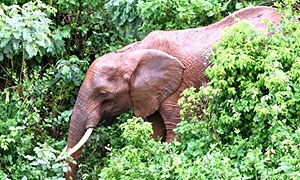
Aberdare National Park - Kenya
Aberdare National Park is located about 150 km (93 miles) east of Nairobi in Central Kenya. The park is home to the African golden cat, Bongo, elephants, wild dogs, buffalo, jackal, eland, giant forest hogs black and white colobus monkeys, and the elusive black leopard. The Aberdare National Park birdlife features over 250 bird species which include the endangered Aberdare cisticola, Jackson’s spurfowl, sparrow hawk, African goshawk, African fish eagles, sunbirds, and plovers, buzzards, African crown eagle, are plenty of butterflies. The Park is renowned for its waterfalls which include The Gura Waterfall, the most precipitous fall in Kenya, which cascades 300m into an impenetrable ravine, the spectacularly lovely Karura Falls, the Chania Falls, the Magura Falls, and Queen’s Cave. Activities in the park include day & night game drives, hiking, walking to the waterfalls, trout fishing, bird watching, camping, photography, trekking, horse riding, and visiting Mau Mau caves. The best times to visit are January and February and June through September. The park has 5 entrance gates that visitors can use which include the Ark, Treetops, Kiandagoro, Shamata, Mutubio, and Ruhurni gates. Aberdare National Park safari lodges, such as treetops lodge, Aberdare country club, fishing lodge, and several campsites.
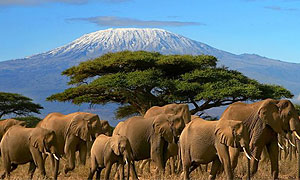
Amboseli National Park - Kenya
Declared a National Park in 1974, Amboseli National park is located in southern Kenya, almost on the southern border with Tanzania, close to Mount Kilimanjaro. The park covers 392 km² (151 sq mi) and is famous for close-up elephant encounters with its large elephant herds, flanked by the impressive Mount Kilimanjaro in neighbouring Tanzania. The highlights of Amboseli National Park include close-range encounters with wild elephants, Africa’s highest mountain, Mt Kilimanjaro as a scenic backdrop, Maasai cultural encounters, swamps hosting numerous buffalos, hippos and a variety of water birds, home to four of the Big Five of Africa - lion, leopard, bufalo and elephant. Amboseli is about a 4-hour drive (240km) from Nairobi. The game park is situated in the Loitoktok District, in the Rift Valley Province of Kenya. Amboseli Wildlife includes wildebeest, zebra, buffalo, giraffe and plains game. Predators include lions, cheetahs, wild dogs, leopards, caracal, jackals, hyenas and serval cats. Other inhabitants include crocodile, mongoose, porcupine, warthog, hyrax, small dik- dik, impala and Lesser Kudu, among other antelopes. Amboseli hosts abundant birdlife, with over 400 bird species. Birdlife includes pelicans, bee-eaters, Egyptian geese, kingfishers, crakes, hammerkops and 47 types of raptors, including various eagle species.

Arabuko Sokoke National Park - Kenya
Arabuko Sokoke National Park is a 6sq km reserve near Malindi and Watamu reserve and park. It is the largest surviving coastal dry forest in East Africa, and is about 110km north of Mombasa. Arabuko Sokoke Forest Reserve provides important habitat to unique and endangered birds, insects, and animals. The major attractions are about 600 bird species, butterflies, and coastal forests. The climate is humid with a mean annual temperature ranging from 22-34 degrees Celcius. Rainfall is around 500 mm per year. The park consists of Forest vegetation. Forest animals include Golden-rumped elephant-shrew, Sokoke bushy-tailed mongoose, Ader’s duiker, water and bushbucks, African civet, blotched genet, elephants, and Sykes monkeys. Forest birds: In excess of 230 species have been recorded. It is a great reserve for bird watching and among the bird species includes Sokoke pipit Amani sunbird, Fischer’s turaco, Clarke’s weaver, and golden woodpecker, among others. When to go: The Forest Reserve is open all year round; the best time for nature walks is during the cool of the day, early morning or late afternoon. Access by road is through Mombasa, 75km on tarmac road. Visitors who want to fly can use Malindi and Mombasa airports.
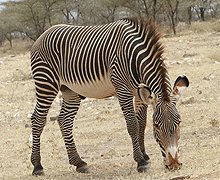
Arawale National Reserve Garissa County - Kenya
Arawale National Reserve is located in Garissa County in the North Eastern province, 5 km from the left bank of the Tana river. Arawale was gazetted in 1973 covering an extension of 533 km² and with the primary purpose of protecting an extremely rare antelope species which is found only in this region, the hirola or Hunter's hartebeest. The landscape in this area is mostly open grassland and wooded grassland habitats with short grass. Arawale is located 250 km north of Mombasa and 130 km north of Malindi. The Reserve lies 77 km south of the town of Garissa in North Eastern Kenya. Arawale National Reserve offers an opportunity to see a wide range of wildlife species including four globally threatened species: Hirola, Grevy’s zebra, East African wild dog, and East African cheetah. Others include Elephants, reticulated giraffes, Desert warthog, Lesser kudu, Buffalo, Somali bush babies, hippos, and crocodiles. Arawale National Reserve landscape is mostly a dry thorn-bush savannah and the reserve has no accommodations - lodges or tented camps. Activities in the reserve include bird watching, guided nature walks, camping, and picnics. The Park is open daily from 6.00 am to 7.00 pm.
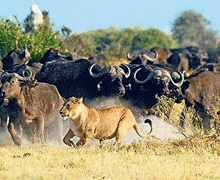
Buffalo Springs National Reserve - Isiolo County in Northern Kenya
Buffalo Springs National Reserve is located in Samburu County, on the banks of the Ewaso Ng’iro River. It borders Samburu National Reserve, which is on the other side of the river, as well as the Kalama Community Conservancy. Buffalo Springs National Reserve and the nearby parks have what’s known as the ‘Special 5’ – the gerenuk, reticulated giraffe, Grevy’s zebra, Somali ostrich, and the beisa oryx, as well as plenty of elephants! The park is a 6 – 7 hour drive from Nairobi.By Plane: There are daily scheduled flights to airstrips in Buffalo Springs, or neighboring Samburu National Reserve from Nairobi and Mombasa airports. The best time to visit Buffalo Springs National Reserve is in Kenya’s dry seasons, from June to September/early October (cooler season) or December to March (warmer season). Accommodations in Buffalo Springs National Reserve include Samburu Sopa Lodge, Samburu Simba Lodge, Ashnil Samburu Camp, Umoja Campsite, or Lion’s Cave Camp. Activities in Buffalo Springs National Reserve include going on game drives, swimming in the natural pool in Buffalo Springs, and visits to Samburu villages. Wildlife includes buffaloes, impalas, zebra, wild dogs, waterbucks, impalas, hyenas, elephants, cheetahs, kudus, leopards, lions, elands, giraffes, gazelles, giraffes, oryxes, gerenuk, and many more.

Central Island National Park
Central Island National Park also known as Crocodile Island, is a volcanic island located in the middle of Lake Turkana in Kenya. The Island has three scenic crater lakes i.e. Crocodile, Flamingo, and Tilapia that provide breeding grounds for the world’s largest concentration of Nile crocodiles. Central Island National Park is almost in the middle of Lake Turkana, The Jade Sea. It’s a designated world heritage site and covers an area of about 5 square km. The park is a bird’s paradise and is a spectacular home for over 23 migrant birds and it is an important bird area – IBA. Central Island National Park is one of the largest breeding grounds for the Nile crocodiles and thus the Crocodile Island commonly known as Chooro by the local community. The park harbors several unique species of fish, while some of them are endemic to the island. Lake Turkana is home to some of the world’s venomous reptiles including the saw-scaled viper, puff adder, and cobras. Species of fish include the huge Nile Perch, large Tilapia, and puffer fish in seawaters which shows Turkana's Prehistoric connection to the Red Sea. Visitors can enjoy game viewing, camping, boating, nature trail hiking, sport fishing, and sightseeing.

Chyulu Hills National Park Tsavo & Amboseli - Kenya
Chyulu Hills National Park is located 232km/ 144mi from Nairobi and 250 km/155mi from Mombasa. 1-hour light aircraft flight from Nairobi. Tucked away between Tsavo West National Park and Amboseli National Park, Chyulu Hills National Park boasts striking and diverse landscapes. Activities in Chyulu Hills include safari walks, game drives, camping, mountain climbing, bird watching, and horseback safaris. There is no accommodation inside the park, but there are two very exclusive lodges offering a full range of activities in Maasai concessions on the foothills of the Chyulu Hills. Chyulu Hills Campsite and Chyulu Camp provide basic campsite provisions including showers, toilets, running water, clean bathrooms, and a thatched area where guests can pitch tents. The weather in Chyulu Hills National Park in March is pleasantly warm humid but cool, with average highs of 90°F (32°C) and lows of 66°F (19°C). Chyulu Hills can be visited year-round, but wildlife viewing is usually best in the dry months from June to October and January to February. Visitors to Chyulu Hills will see buffalo, bushbucks, elands, elephants, leopards, giant forest hogs, bush pigs, reedbucks and giraffes, reptiles, lions, klipspringer, zebras, baboons, and Sykes’ monkey. Birds of chyulu include African Harrier-Hawk, White-backed Vulture, Bateleur, Crowned Eagle, Martial Eagle etc.
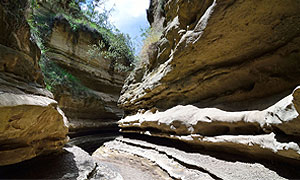
Hell's Gate National Park, Naivasha - Kenya
Hell’s Gate National Park covers an area of 68.25 km² and is situated in the environs of Lake Naivasha about 90 km from Nairobi. The park is 14 km after the turnoff from the old Nairobi-Naivasha highway and was established in 1984. Hells Gate National Park is the ideal venue for a day trip excursion, a camping stopover, or a picnic spot out of Nairobi. The vegetation is mainly grassland and shrubs with wildlife and birdlife in the park. The Park offers a view of the Aberdares Ranges, Lake Nakuru, and nearby Mt Longonot. Attractions at the Hell’s Gate include Fischer Tower, Hell’s Gate Gorge, Obsidian caves, and wildlife. Animals include giraffes, lions, leopards, buffalo, gazelles, and eland antelopes. More than 100 species of birds have been recorded. Activities at the park include camping, game viewing, filming and photography tours, bird watching, climbing, cycling, fisher’s Tower, walks, and Maasai cultural tours. The best time for wildlife viewing is from June to October while the scenery is at its most spectacular during the wet season from November to May. Hell’s Gate has three camping sites: Endachata, Naiburta, and Olduvai, and hotels nearby include Fisherman’s Camp, Ajabu House, Enashipai Resort, and Kedong Ranch House among others.

Kisite-Mpunguti Marine National Park
Kisite-Mpunguti Marine National Park is situated on the southern coast of Kenya, close to Shimoni (south of Wasini Island in Kwale District) near the Tanzanian border. The park covers 11 km2 while the Mpunguti reserve covers 28 km2. Kisite Marine National Park was established in 1973 to protect the scenic islands and special habitats of a wide range of endemic marine animals and breed migratory birds on Wasini Island. Kisite comprises about 250 recorded fish species, 70 resident dolphins, and over 140 cataloged individuals, sea turtles, whales, 56 genera of corals, seagrass, and gastropods. Many seabirds in large nesting colonies and internationally significant numbers of roseate terns and crab-plover. Marine life is in abundance, including triggerfish, moray eels, angelfish, butterflyfish, groupers, parrotfish, wrasses, scorpionfish, pufferfish, damselfish, rays, snappers, green sea turtles, hawksbill turtles, and dolphins. Humpback whales and whale sharks are seasonal. Activities include snorkeling, scuba diving, watching dolphins, sports fishing, and boating. The Marine Park lies 11 km off the Kenyan Coast (at Shimoni) and can only be reached by boat. Accommodation includes self-catering cottages like Shimoni and campsites like Chlobus Campsite or Mpunguti Campsite. Private hotels include Kinondo Poa, Betty's Camp, The Cove Retreat and The Manta Resort.

Kakamega Forest National Reserve (Kenya Wildlife Service)
Kakamega Forest National Reserve is a tropical rainforest located in Kenya's Kakamega and Nandi counties, northwest of Nairobi and near the Ugandan border. It's approximately 418 km from Nairobi, accessible via a 6 to 8-hour drive through Nakuru and Kapsabet, and lies about 50 km north of Kisumu city and 87 km from Eldoret. The forest is managed in two parts: the Northern National Reserve by the Kenya Wildlife Service and the Southern Forest Reserve by the Forestry Department. Visitors can explore the forest on foot through various nature trails, which offer opportunities for forest walking, camping, hiking, primate watching, bird and butterfly watching, game watching, rock climbing, and village walks. Bird watching is particularly rewarding during the early morning or late afternoon hours, accompanied by a local community tour guide. The forest's rich biodiversity includes mammals like bush pigs, giant forest hedgehogs, colobus monkeys, Debrazzar monkeys, and pottos, as well as birds such as the Blue Headed Bee Eater, Black Billed Turaco, Turner’s Eremomela, and Grey Parrots. Reptile enthusiasts can also find species like the Black Lipped Cobra, Rhinoceros Horned Viper, Gabon Viper, and Forest Cobra, making Kakamega Forest National Reserve a vibrant ecosystem teeming with life and an ideal destination for nature lovers and adventure seekers alike.
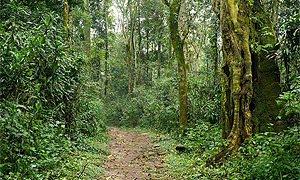
Kakamega Forest Reserve (Kenya Forest Service)
Kakamega Forest Reserve, located in Kakamega County, Western Kenya, is home to Kenya's only tropical rainforest. The forest, divided between the Kenya Wildlife Service (KWS) in the north and the Kenya Forest Service (KFS) in the south, boasts a rich biodiversity with over 360 bird species, 380 plant species, 400 butterfly species, and seven primate species. Major attractions include its diverse wildlife, especially birds, insects, and butterflies. Access to Kakamega Forest is available by road or air. From Nairobi, it's approximately 418 km, with routes through Nakuru, Kericho, Kisumu, and Kakamega town. Visitors can also fly from Nairobi to Kisumu and then drive 90 minutes to the reserve. The best visiting times are the drier periods from December to February and June to July, ideal for hiking and wildlife viewing. Accommodation options within and near the reserve are varied. In the south, the Isecheno camping site and Blue-Shouldered Guest House offer basic facilities, while Rondo Retreat Centre and Luvambo Forest Resort provide more luxurious stays. Community homestays and several hotels in Kakamega town, such as the Golf Hotel and Sheywe Guest House, are also available. The Isecheno KEEP Bandas cater to groups with self-catering facilities.

Lake Nakuru National Park
Lake Nakuru National Park is situated a 3.5-hour drive northwest of Kenya’s capital, Nairobi, and is a bird- and animal watchers haven. Highlights of Lake Nakuru include prolific birdlife – over 400 species including millions of pink flamingos, wildlife including four of the Big Five (all, except the elephant), rare, tree-climbing lions, Makalia Waterfall, beautiful scenery, the lake itself, and the biggest Euphorbia Forest in Africa. Lake Nakuru is a treat for birdwatchers, and you’re likely to see flamingos, herons, pelicans, storks, and the African fish eagle. Lake Nakuru Animals include Rothschild’s giraffes, zebra, hippo, impala, and waterbuck, plenty of baboons, white and black rhinos, lions, monkeys, and more. The lake itself is alkaline and, depending on water levels, can cover up to 40 km2. The Lake Nakuru National Park covers 188 km2. Due to its proximity to the equator, the climate is relatively consistent throughout the year – warm and wet. The park was first a bird sanctuary and then was made a national park in 1968. Numerous Rothschild giraffes were brought in from western Kenya in 1977. In the ’80s, the area was electric-fenced and declared a rhino sanctuary. In 2011, it gained UNESCO World Heritage Site status.
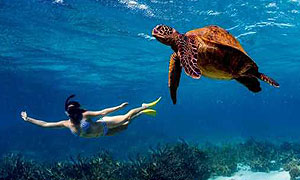
Malindi Marine National Park & Reserve - Kenya Coast
Malindi Marine National Park is located in the Indian Ocean, off the coast of Kenya. The Park lies off Casuarina Point on the southern reaches of Malindi. It is claimed to be the oldest marine park in Africa. The park lies at Malindi, about 118 km north of Mombasa, and is protected and administered by the Kenya Wildlife Service. The Malindi Marine National park extends all the way from the Vasco Da Gama pillar to Watamu. The 6 sq. km (2.3 sq. mi) park borders the larger 213 sq. km (82 sq. mi) reserve which encompasses beaches, mangroves, mud flats, and a variety of coral reefs. The park's attractions include prolific marine life such as sea urchins, starfish, tropical fish, barracuda, green sea turtles, beds of coral species, nine coral fish families, whale sharks, and dolphins. In the reserve, visitors can enjoy recreational snorkeling at coral gardens, scuba diving expeditions, swimming in the warm ocean water, sunbathing, water-skiing, windsurfing, guided birding walks, glass-bottom boat rides, Sea-Bird watching and beach strolls. A trip to the famous Sardinia Magical Island where you can have a barbecue, and fresh seafood for your lunch is a must, and trips to Manyugu, a tidal island, where you can have fresh food.
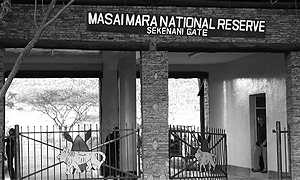
Masai Mara National Reserve & Conservancies
Masai Mara National Reserve & Conservancies, a premier Big 5 safari destination in Africa, established in 1961 and expanded since, it now spans 1,510 sq km, including both the reserve and surrounding conservancies. Renowned for the Great Migration, the Mara witnesses millions of wildebeest, zebras, and gazelles migrating across its savannahs. It is home to the Big Five and a variety of wildlife and can be accessed by road from Nairobi or via daily flights. Optimal visiting times are mid-summer for wildlife viewing or during the quieter periods of April-May and November-December. Activities in the Mara include early morning game drives which offer opportunities to see predators and herbivores at their most active, afternoon drives, which provide excellent wildlife viewing and photography opportunities during the "golden hour" and night drives, available in private conservancies, offer sightings of nocturnal animals, while balloon safaris provide a serene aerial view of the landscape, concluding with a champagne breakfast. Scenic helicopter flights offer a bird’s-eye view of the region, and wildebeest migration safaris focus on river crossings. Bird watching, with over 470 species, is best from November to April. Nature walks outside the main reserve, Maasai village visits, bush meals, and horseback safaris add to the experience. Lodges and camps in the Mara blend luxury with natural immersion, featuring en-suite bathrooms, private decks, and communal areas. The ecosystem includes private Maasai conservancies. Key conservancies like Mara North and Mara Naboisho offer exclusive safari experiences with low-impact tourism and abundant wildlife.

Meru National Park & Meru Conservation Area
Meru National Park is one of the least visited and therefore one of the least spoiled of Kenya’s national parks. The equator bisects the park whose 870 km2 (340 sq mi) landscape is mainly given over to bushland but with grasslands in the west. Thick forests grow along the park’s many watercourses. The park is located east of Meru, 350 km (220 mi) from Nairobi. The park has 13 rivers that feed into the Tana river. Hundreds of bird species have made the park their home – among them the Pel’s Fishing Owl, rare Peter’s Finfoot, Palm-Nut Vulture, Somali Ostrich, Fulvous Whistling‑Duck, Egyptian Goose etc. Animals in the park include leopard, cheetah, elephant, lion, both Grevy’s, plains zebra, eastern black rhinoceros, southern white rhinoceros, hartebeest, hippopotamus, reticulated giraffe, and some decent-sized herds of buffalo. Aside from the scenery and wildlife, tourist attractions include the once home of George and Joy Adamson, Adamson's Falls, the burial sites of Joy Adamson and Elsa the Lioness, views of Mount Kenya, and the Tana River. Meru was one of the two areas in which conservationists George Adamson and Joy Adamson raised Elsa the Lioness made famous in the best-selling book and award-winning movie Born Free.
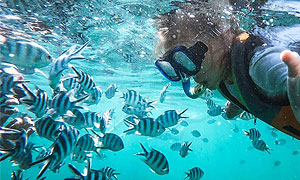
Mombasa Marine National Park & Reserve
Mombasa Marine National Park & Reserve was established in 1986 to protect its dazzling marine life, this 10 km² park and its surrounding 200 km² reserve offer a paradise for divers, snorkelers, and sunbathers alike. Take a scenic road trip from Nairobi or a quick flight to Mombasa. Upon arrival, several entry points lead you to pristine beaches fringed by swaying palms. Dive into a kaleidoscope of vibrant coral reefs, home to colorful fish and gentle giants like leatherback and green sea turtles. Playful dolphins might even join your underwater adventure! Explore the underwater world year-round through diving or snorkeling. Pristine beaches beckon sunbathers seeking relaxation, while the cool ocean breeze refreshes the soul. Fishing enthusiasts can test their skills, and birdwatchers can spot unique species like crab plovers. Choose a thrilling boat tour to see the underwater world through a glass-bottom boat, experience local culture on a traditional dhow, or feel the wind in your hair on a speedboat ride. Windsurfers and water skiers can test their skills on the clear waters. While the park itself has no accommodation, luxurious resorts lie nearby. Unwind at the Serena Beach Resort, indulge in spa treatments at Sarova Whitesands, or enjoy family fun at Voyager Beach Resort.

Mount Elgon National Park
Mount Elgon National Park is located 470 km away from Nairobi on the western border of Kenya with Uganda. Mount Elgon is Kenya’s second-highest mountain. It is an ancient eroded volcano that erupted over 24 million years ago. On its summit is a huge flat-topped basalt column called Koitobos. The park is home to a variety of plants and wildlife, and it is endowed with a breathtaking panorama of cliffs, caves, waterfalls, gorges, mesas, calderas, hot springs, and mountain peaks.The most popular areas to visit are the four vast caves, which are frequented by night visitors such as elephants and buffaloes. These animals come to lick the natural salt found on the cave walls. The Kitum cave, with overhanging crystalline walls, enters 200 metres into the side of Mount Elgon. The breathtaking natural beauty of the park can be best appreciated from the Endebbe’s Bluff where one gets a panoramic view of the area’s escarpments, gorges, mesas, and rivers. The highest peak of Mount Elgon on the Kenyan side, Koitoboss, measures 13,852 feet (4,155 metres), and is easily reached by hikers in about two hours from the road’s end. Apart from climbing the mountain, tourists visit the park for game viewing, nature walks, bird watching, cave exploration, and camping.
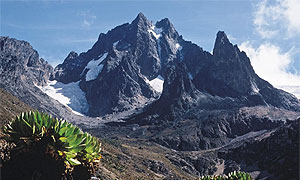
Mount Kenya National Park
Mount Kenya National Park & Reserve, a UNESCO World Heritage Site, is located in northeast Kenya, about 110 miles from Nairobi. Accessible by road or an hour's flight from Nairobi to Nanyuki Airstrip, the park has six gates: Naro Moru, Kihari, Mawingu, Sirimon, Kamweti, and Chogoria. Established in 1949, the park spans approximately 700 square kilometers, protecting the region from 11,000ft to the peak of Mount Kenya at 17,058 feet. The park is renowned for its diverse landscapes, including rivers, forests, moorland, rock, and ice, crowned by the twin peaks of Batian and Nelion. The vegetation varies with altitude, featuring alpine and sub-alpine flora, bamboo forests, moorland, and tundra. Mount Kenya, Africa's second-highest mountain, offers technical climbing on Batian and Nelion, and trekking to Point Lenana at 4,984 meters. Wildlife in the park includes buffalo, elephants, colobus monkeys, hyraxes, mongoose, suni, duikers, bushbucks, waterbucks, elands, and rare sightings of leopards, bongos, and giant forest hogs. Over 130 bird species add to the park's biodiversity. Visitors can engage in game viewing, mountain climbing, camping, picnicking, bird watching, and photography. Post-hike, accommodations at the mountain's base provide relaxation and activities like fishing, golfing, and cultural visits. Optimal hiking periods are December to February and August to September.

Mount Longonot National Park
Mount Longonot National Park is a stratovolcano situated 90 km northwest of Nairobi, southeast of Lake Naivasha in Kenya's Great Rift Valley. Established in 1984, the park spans 52 square kilometers, ranging in elevation from 1,875 to 2,776 meters above sea level. Its landscape is characterized by grasslands, shrubs, and acacia trees, with a notable V-shaped valley and sparse vegetation cover. The park features a unique forest within its crater and offers scenic views from the crater rim across the Rift Valley to Lake Naivasha. Accessible by road via the Nakuru-Nairobi Highway, taking approximately 1.5 to 2 hours from Nairobi. Alternatively, travelers can charter a flight from Wilson Airport in Nairobi to Naivasha Airstrip, followed by a 30-40 minute ground transfer to the park. The climate is hot and dry, with temperatures averaging 25°C. Wildlife includes buffaloes, lions, zebras, giraffes, and various antelopes, while activities like hiking to the crater rim, game viewing, rock climbing, camping at Olongonot Campsite, nature walks, bird watching, and bike riding cater to diverse interests. Nearby accommodations include camping facilities at Olongonot, or lodges and resorts in Naivasha such as Lake Naivasha Sopa Resort, Great Rift Valley Lodge, Crater Lake Tented Camp, and Naivasha Kongoni Lodge.

Nairobi National Park
Nairobi National Park is the closest game park to Kenya’s capital city of Nairobi in about 10km which is in south-central Kenya, a short drive south of Nairobi’s central business district. Covering a total land area of 117 km² (45 square miles), and at an altitude of about 1500m (5,000 feet) above sea level, this game park is in comparison to most of East Africa’s national parks. Nairobi National Park is a unique ecosystem electrically fenced on the northern, eastern, and western boundaries whereas it's southern the boundary is not fenced and thus is open to the Kitengela Conservation Area and the Athi-Kapiti plains that allow movement of wildlife species between the park and the adjacent Kitengela plains. The wildlife highlight of Nairobi National Park includes over 100 species of mammals - four of the big 5 animals (white Rhino and Black Rhino, lions, leopards, buffaloes), baboon, gazelle, zebra, cheetah, hyena, hartebeest, wildebeest, hippo, eland, warthogs, impala, giraffe, ostrich, jackal, and crocodile among others. Nairobi National Park has more than 520 bird species, making it a great birding destination. Notable birds in the Park include Maasai Ostrich, African Darter, African Finfoot, Goliath Heron, Saddle-billed Stork, Spur-winged Goose, African Crowned Eagle, and Secretarybird, among others.
Nairobi National Park
Click Here
Ol Donyo Sabuk National Park
Ol Donyo Sabuk National Park is located in Machakos County in Kenya, 80 km north of Nairobi. It was established in 1967 on an area covering 20 km2. The park was named out of mountain OI Donyo Sabuk, which means “large mountain” in the Maasai language. Wildlife includes leopards, bushbucks, Impalas, Columbus Monkeys, Duikers, Aardvarks, Olive Baboons, Banded Mongoose, Crested Porcupines, reptiles such as African Rock Pythons, Boomslang, Vine Snakes, Green Mambas, Monitor Lizards and striped skinks. The park is also home to 45 bird species with African Hawk-Eagle, African Pied Wagtail, White Browed Weaver, Streaky Seed Eaters, and Black Kites easily sighted. In Ol Donyo Sabuk, the months of January to March are hot and dry, April to June are hot and wet, July to October are very warm and dry while the months of November and December are warm and wet. Activities include game viewing, hiking, fourteen Falls, scenic views of Mt. Kenya and Mt. Kilimanjaro, Lord William McMillan’s Grave, montane landscape, bird watching, and nature walks. Hotels nearby include Chania Tourist lodge, Trade Winds lodges, Cool Tavern House, and Blue post hotel, There are several camping sites available including Turaco Public campsite, Rock Hyrax and Summit Campsite.
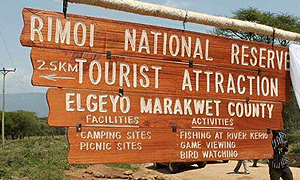
Rimoi National Reserve - Elgeyo Marakwet County, Kenya
Rimoi national reserve is a small game park in Kenya covering an area of 66 km squared adjacent to Lake Kilmarnock at the rift valley province. Rimoi national reserve is renowned for its large herds of elephants some of these come from as far as Turkana and Samburu. The reserve is neighbored by the homes of a special tribe in Kenya known as the Kalenjin tribe who are athletes, especially runners. Wildlife in Rimoi national reserve includes elephants, bush pigs, warthogs, Dik Dik, pangolins, Genet, impalas, monkeys snakes, tortoise agama, and porcupines. Activities here include camping - there is a campsite where one can pitch tents. One can also go for a guided walk to see birds which include turacos, honeyguides, pigeons, sunbirds, Weaver, and hornbills. Hiking is also a popular activity - hike up to the Cheptarit hill where you can have mouth-dropping views of the valley alongside beautiful hot springs. Rimoi national reserve can be accessed by road or air. It’s approximately a 5-6 hours drive from Nairobi covering a distance of about 300 kilometers and 40 kilometers from Eldoret town, the reserve can be accessed by air through an airstrip at Eldoret.
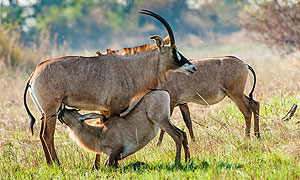
Ruma National Park
Ruma National Park, spanning 120 sq. km, is located in the Lambwe River Valley and is bordered by the Kanyamwa Escarpment to the southeast and the Ruri Hills to the north. The park features a diverse landscape that includes riverine woodland, rolling savannah, escarpments, and cliffs. It is the last remaining sanctuary in Kenya for the endangered roan antelope. Ruma National Park can be reached by road through the Main Gate (Kamato Gate) or the Nyatoto Gate, with routes starting from Homa Bay. By air, visitors can fly from Nairobi to Homa Bay, then take a 42 km drive to the park. The park hosts a variety of wildlife, including African elephants, eastern black rhinos, roan antelopes, buffaloes, giraffes, leopards, and more. It is also a bird watcher’s paradise with over 400 species of birds, including the rare blue swallow. Visitors to Ruma National Park can enjoy activities such as game drives, nature walks, bird watching, camping, and hiking in the Gwassi hills. For accommodation, the park offers the Oribi Guest House, a self-catering facility with solar power and DSTV. Nearby lodging options include Ruma River Lodge and Karibuni Eco-Cottages, which provide comfortable and sustainable accommodation.

Samburu National Reserve - Kenya
Samburu National Reserve lies in the Samburu County of Kenya, on the banks of the Ewaso Nyiro River in Northern Kenya. It is spread over an area of about 165 km² some 350 km north of the vibrant city of Nairobi. Samburu is home to Africa’s Big Five, a myriad of other animals, and over 450 bird species, providing an authentic bush experience for both first-time visitors and seasoned adventurers. Large herds of elephants roam the area, often covered in the red earth of the region, while the rare Gerenuk gazelle, known for its long neck and ability to stand on hind legs to feed, is a special sight. The Samburu people, a clan of the Maasai, live in the region and are known for their semi-nomadic herding lifestyle, vibrant cultural expressions, and deep knowledge of the environment. Visitors can engage in various activities such as river rafting, camel riding safaris, and visiting the Sarara Singing Wells. The climate is pleasant throughout the year, with the best game viewing during the drier months. Samburu’s dedication to conservation is evident through the work of the Save the Elephants Organisation, which combats poaching and monitors elephant populations.
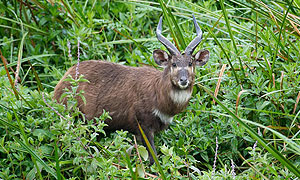
Saiwa Swamp National Park
Saiwa Swamp National Park, Kenya’s smallest national park, spans only 3 square kilometers and is near Kitale in Trans-Nzoia County. Saiwa Swamp National Park is accessible by road, 22 kilometers from Kitale town, or by air via the Kitale airstrip, 27 kilometers away. The park gates are open from 6 am to 7 pm. The park features approximately 7 kilometers of well-maintained wooden walkways and trails, and three timbered viewing platforms for spotting the elusive Sitatunga. Saiwa Swamp is a haven for over 370 bird species, such as the lesser Jacana, grey heron, African black duck, Ross’s turacos, and yellow bishop. It also hosts various reptiles and amphibians, including the side-striped chameleon, forest cobra, and blue-headed tree agama lizard. The park is also rich in dragonflies, damselflies, and butterflies. Visitors can explore the park through several activities. The Safari Walk allows close-up views of the park's flora and fauna, while Photography Safari Tours cater to both amateur and professional photographers. Birdwatching is a major attraction, with the park boasting an impressive variety of bird species. Several picnic points along the trails offer a serene environment to relax. Camping in the park offers a rewarding experience, with the sounds of wildlife providing a natural lullaby. The park's tranquil setting is also ideal for corporate events and team-building activities. Game viewing can be done on foot or from observation points, providing an unforgettable experience of observing wildlife in their natural habitats.
Shaba National Reserve
Shaba National Reserve, in the arid north of Kenya near Isiolo, is 239 sq km on the Ewaso Ng'iro River. It forms an ecological entity with Samburu and Buffalo Springs reserves, where wildlife roams freely. The reserve's remoteness offers stunning scenery, including Shaba Hill, steep ravines, and views of Ol Ololokwe Mountain. Ewaso Ng'iro River supports varied wildlife such as Somali giraffes, oryx, Somali ostriches, Grevy's zebras, and gerenuks. Lionesses, leopards, and cheetahs are typical along the riverine. The best time for game viewing is June to September and January to February. Shaba is accessible by road (5–6 hours from Nairobi) or by air (flights from Wilson Airport to local airstrips). Some of the activities include game drives, camel treks, walking safaris, and visits to Samburu villages. The reserve also provides climbing and crocodile viewing. Accommodation is provided at Sarova Shaba Game Lodge, which is a 4-star lodge offering modern comforts and picturesque views of the river. Shaba National Reserve with its untamed beauty, abundance of wildlife, and thrilling experiences is a secret paradise for those safari visitors who desire tranquility and adventure.
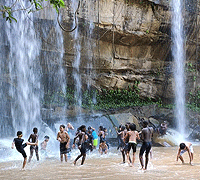
Shimba Hills National Reserve
Shimba Hills National Reserve, situated 33 km southwest of Mombasa near Kwale Town, spans 321 square kilometers with elevations ranging from 120 to 450 meters above sea level. It has one main entrance and three secondary gates (Kivumoni Gate, Kidongo Gate, Shimba Gate), as well as a small airstrip for accessibility. This pristine area features a varied landscape of rolling meadows, giant primeval trees, and dense coastal rainforests interspersed with grasslands and riverine forests along hills and valleys. The reserve is renowned for its rich biodiversity, housing approximately 500 elephants and serving as a sanctuary for rare wildlife such as leopards and the impressive sable antelope, often seen grazing alongside buffalo herds. Its vegetation is unique, comprising over 1,100 plant species, including 19 endangered tree species and iconic orchids like Eulophia Livingstoniana and Eulophia Wakefieldii. Visitors to Shimba Hills can partake in safari drives to observe wildlife in their natural habitat, hike to the spectacular Sheldrick Waterfalls cascading 25 meters down amidst lush greenery, and enjoy picnics or camping amidst the tranquility of Mkongani and Mwaluganje forests. The reserve offers stunning panoramic views towards the Indian Ocean and, on clear days, glimpses of Mt Kilimanjaro in Tanzania, providing a picturesque backdrop for nature enthusiasts and photographers alike.
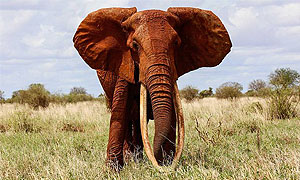
Tsavo East National Park
Tsavo East National Park was established in 1948 and spans approximately 13,747 square kilometers. It’s part of the larger Tsavo National Park, which was later divided into Tsavo East and Tsavo West, separated by the Nairobi-Mombasa highway and named after the Tsavo River. The park is famous for its red-dusted elephants, with a population exceeding 10,000. It’s also known for the ‘man-eating’ lions of Tsavo, which gained notoriety in 1898 for attacking railway workers, with varying reports of fatalities. These lions are characterized by their shorter manes, possibly due to Tsavo’s hot, dry environment. Tsavo East is home to the Big Five: elephants, lions, leopards, buffalos, and rhinos, with the black rhino being closely monitored due to poaching threats. The park also shelters endangered hirola antelopes and a diverse range of wildlife, including cheetahs, hyenas, crocodiles, hippos, giraffes, and Grevy’s zebras, as well as species typical of northern Kenya like gerenuk and Somali ostrich. Birdwatchers can enjoy over 500 bird species, such as the black kite and crowned crane. The park’s geography features the dry plains of the Yatta Plateau and the Galana River, which provide vital water sources for wildlife and are key spots for game viewing, especially at Aruba Dam and Lugards Falls.

Tsavo West National Park
Tsavo West National Park was established alongside its sister park Tsavo East in 1948 and covers an area of approximately 9,065 square kilometers. It forms the western half of the colossal Tsavo National Park. The park is renowned for its unique and diverse ecosystems, ranging from lava flows and volcanic cones to springs, savannahs, and mountain forests. It’s a land marked by the Mzima Springs, where crystal clear water gushes from under parched lava rock, creating an oasis in the rugged wilderness. Tsavo West is a sanctuary for a myriad of wildlife, including the Big Five: elephants, lions, leopards, buffalos, and rhinos. It’s particularly famous for its man-eaters of Tsavo, lions with a historical reputation for preying on railway workers during the park’s early days. These lions are noted for their shorter manes, a trait adapted to the park’s arid conditions. The park’s rhino sanctuary, known as the Ngulia Rhino Sanctuary, is a critical conservation effort, providing a haven for these endangered species. Over 600 bird species adorn the skies of Tsavo West, making it a paradise for birdwatchers. The landscape is a dramatic tableau, with the Shetani lava flows and Poacher’s Lookout offering panoramic views of the teeming wildlife below.

Watamu Marine National Park
Watamu Marine National Park & Reserve, located about 140 km north of Mombasa and 25 km south of Malindi, was established in 1968 and spans an area of approximately 10 square kilometers. The park's coral gardens are just 300 meters from the shore, hosting around 600 species of fish and 110 species of stony coral. The park’s waters are a sanctuary for green turtles, and its beaches are vital nesting grounds for these endangered creatures. The Watamu Turtle Watch program ensures the protection of these turtles, contributing to the park’s high success rate as a nesting site. Visitors can explore the reefs’ vibrant marine life, including whale sharks, manta rays, and barracudas. Watamu Marine Park is not only a haven for marine life but also a hotspot for birdwatching, with over 100 species of birds found in its cultivated gardens and bushlands. The park’s natural beauty can be best appreciated from the white sandy beaches, where one can enjoy panoramic views of the turquoise Indian Ocean. Watamu Marine Park offers a variety of activities for visitors, including snorkeling, water skiing, windsurfing, and glass-bottom boat tours. The park is part of a UNESCO-recognized World Biosphere Reserve, highlighting its global significance for conservation and sustainable use of natural resources.
Booking & Reservations Kenya National Parks Game Reserves Contact
Mobile: +254-721-242-711
WhatsApp: +254-721-242-711
Reservations: +254 718-179-967
Email: [email protected]
Website: https://africanspicesafaris.com

